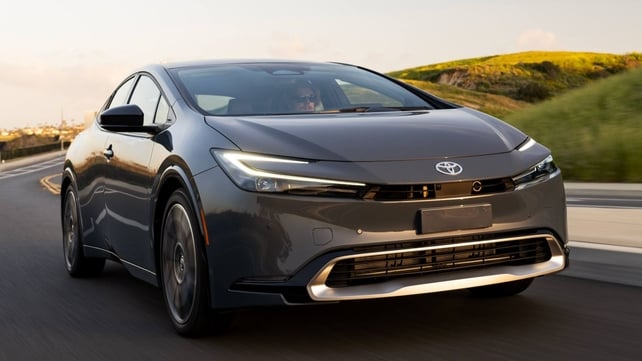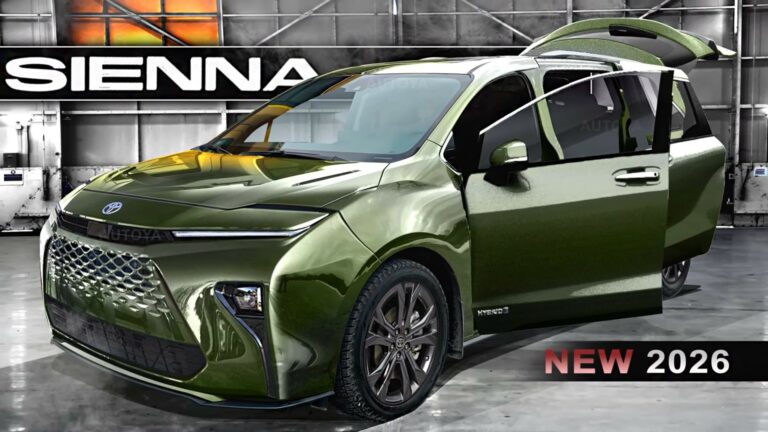Toyota Prius Plug-In 2026 Release Date
Overview of the Toyota Prius Plug-In
The Toyota Prius Plug-In is a hybrid electric vehicle that combines a gasoline engine with an electric motor and a lithium-ion battery pack. It offers drivers the benefits of both electric and gasoline power, allowing them to travel short distances on electric power alone and switch to gasoline when needed. The Prius Plug-In is designed to be fuel-efficient and environmentally friendly, with a sleek and aerodynamic design that helps reduce drag and improve performance.
The Prius Plug-In’s powertrain consists of a 1.8-liter four-cylinder gasoline engine that produces 98 horsepower and 105 lb-ft of torque, and an electric motor that generates 71 horsepower and 120 lb-ft of torque. The electric motor is powered by a 8.8 kWh lithium-ion battery pack that allows the Prius Plug-In to travel up to 25 miles on electric power alone. The Prius Plug-In’s fuel economy is rated at 133 MPGe in electric mode and 54 MPG in hybrid mode.
Technology and Features

The 2026 Toyota Prius Plug-In is expected to be a technological marvel, featuring an array of cutting-edge features that enhance the driving experience. From its advanced infotainment system to its comprehensive safety suite, the Prius Plug-In aims to set new standards in the plug-in hybrid segment.
Infotainment System
At the heart of the Prius Plug-In’s interior is a state-of-the-art infotainment system that seamlessly integrates with the driver’s smartphone. The system features a large, high-resolution touchscreen display that provides easy access to a wide range of features, including navigation, audio, and climate control.
The infotainment system also supports wireless Apple CarPlay and Android Auto, allowing drivers to mirror their smartphone apps on the car’s display. This integration provides access to popular apps like Spotify, Google Maps, and Waze, ensuring that drivers stay connected and entertained on the road.
Safety Features
Safety is a top priority for Toyota, and the Prius Plug-In is no exception. The car is expected to come equipped with Toyota Safety Sense 3.0, a comprehensive suite of safety features that includes:
- Pre-Collision System with Pedestrian Detection
- Lane Departure Alert with Steering Assist
- Automatic High Beams
- Dynamic Radar Cruise Control
- Road Sign Assist
These features work together to provide drivers with enhanced awareness of their surroundings and help prevent accidents.
Driver-Assist Technologies
The Prius Plug-In is also expected to offer a range of driver-assist technologies that make driving more convenient and enjoyable. These technologies include:
- Adaptive Cruise Control
- Lane Keeping Assist
- Blind Spot Monitoring
- Rear Cross-Traffic Alert
These technologies help drivers stay in their lane, maintain a safe following distance, and detect potential hazards, reducing stress and improving overall driving comfort.
Connectivity Options
The Prius Plug-In is designed to keep drivers connected on the go. The car is expected to offer a Wi-Fi hotspot, allowing passengers to access the internet and stream content from their devices.
Additionally, the Prius Plug-In is compatible with Toyota’s Remote Connect app, which allows drivers to remotely lock and unlock their car, start the engine, and monitor the car’s status from their smartphone.
Unique and Innovative Features
The Prius Plug-In is expected to stand out from its competitors with a number of unique and innovative features. One such feature is the Solar Charging System, which uses solar panels integrated into the roof to generate electricity and extend the car’s electric range.
Another innovative feature is the Predictive Efficient Drive system, which uses artificial intelligence to analyze driving patterns and optimize the car’s performance for maximum efficiency. This system can adjust the car’s throttle response, braking, and air conditioning to minimize fuel consumption.
Pricing and Availability

The pricing of the 2026 Toyota Prius Plug-In is still under wraps, but experts speculate that it could start at around $30,000. This would be a slight increase over the current model, which starts at $28,525. However, the plug-in hybrid version is expected to offer more features and a longer electric range, making it a more attractive option for eco-conscious consumers.
Availability
The 2026 Toyota Prius Plug-In is expected to be available in most major markets, including the United States, Canada, and Europe. It is likely to go on sale in the second half of 2025, with pre-orders and reservations opening in early 2025.
Comparison with Competitors
The Toyota Prius Plug-In is a highly anticipated vehicle in the plug-in hybrid market. It faces competition from several established rivals. Let’s examine how it compares to some of its key competitors.
Below is a table highlighting the similarities and differences between the Prius Plug-In and its rivals:
Similarities and Differences
| Feature | Toyota Prius Plug-In | Honda Clarity Plug-In | Hyundai Sonata Plug-In | Kia Optima Plug-In |
|---|---|---|---|---|
| Electric range (miles) | ~35 | ~48 | ~30 | ~29 |
| Fuel efficiency (MPGe) | ~133 | ~110 | ~99 | ~103 |
| Horsepower | 121 | 181 | 202 | 202 |
| Price | ~$35,000 | ~$34,000 | ~$34,000 | ~$35,000 |
The Prius Plug-In offers a comparable electric range to its rivals and has the highest fuel efficiency. However, it has a lower horsepower rating than the Hyundai Sonata and Kia Optima Plug-Ins. In terms of pricing, the Prius Plug-In is in line with its competitors.
Advantages and Disadvantages
Toyota Prius Plug-In
- Advantages: High fuel efficiency, proven hybrid technology, spacious interior
- Disadvantages: Lower horsepower, smaller electric range than some rivals
Honda Clarity Plug-In
- Advantages: Longer electric range, more powerful engine
- Disadvantages: Lower fuel efficiency, higher price
Hyundai Sonata Plug-In
- Advantages: Most powerful engine, spacious interior
- Disadvantages: Lower fuel efficiency, smaller electric range
Kia Optima Plug-In
- Advantages: Most powerful engine, spacious interior
- Disadvantages: Lower fuel efficiency, smaller electric range
Q&A
When is the expected release date of the Toyota Prius Plug-In 2026?
Although Toyota has not officially announced a specific release date, industry experts speculate that the Prius Plug-In 2026 will make its debut in the latter half of 2025 or early 2026.
What are the key design changes in the Prius Plug-In 2026?
The Prius Plug-In 2026 is expected to feature a more aerodynamic and futuristic design, with a sleeker profile and sharper lines. It may also incorporate sustainable materials and advanced lighting technology.
What are the expected powertrain specifications of the Prius Plug-In 2026?
Details about the powertrain are still under wraps, but it is anticipated that the Prius Plug-In 2026 will feature an upgraded hybrid system, combining a fuel-efficient gasoline engine with a powerful electric motor. The electric range is also expected to be extended, allowing for longer zero-emission driving.
What advanced technology can we expect in the Prius Plug-In 2026?
The Prius Plug-In 2026 is rumored to be equipped with a suite of advanced technologies, including an enhanced infotainment system, advanced driver-assist features, and improved connectivity options. It may also incorporate cutting-edge safety systems and autonomous driving capabilities.
How does the Prius Plug-In 2026 compare to its competitors?
The Prius Plug-In 2026 is expected to face competition from other hybrid and electric vehicles, such as the Hyundai Ioniq Plug-In Hybrid, Kia Niro Plug-In Hybrid, and Honda Clarity Plug-In Hybrid. It will likely offer a combination of superior fuel efficiency, performance, and technology, making it a compelling choice in the eco-conscious automotive market.



